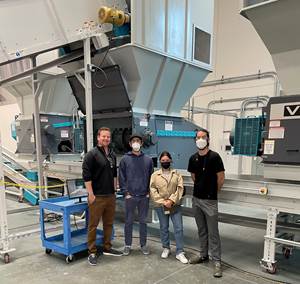Conair Launches New Viper Granulator Product Line
Seven different models are on display at the show, in configurations for injection molding, blow molding and both pipe/profile and film/sheet extrusion.
NPE2018 kicked off Sunday afternoon when Conair officially launched its entirely new portfolio of Viper granulators with standard features that include improved sound insulation, hardened and water-cooled cutting chambers on most models, as well as bigger screens for increased throughput compared to the company’s previous offerings. Seven different models are on display at the show, in configurations for injection molding, blow molding and both pipe/profile and film/sheet extrusion. Conair is exhibiting in Booths W1845, W2163 and S14045.
From small press-side units to large, central granulators, the new Viper product line includes 14 different models with rotor diameters of 6, 8, 12, 17 and 23 inches (140, 200, 300, 420 and 570 mm), and maximum throughputs from 80 lb/hr (36 kg/hr) to 3800 lb/hr (1724 kg/hr). Tangential-feed cutting chambers are standard on smaller grinders, while large units come in a super-tangential configuration to facilitate feeding of large and bulky scrap. Three-blade open rotors are also standard, and other rotor designs are available. Larger granulators and specialty units will be added to the line in the near future.
“The design of our new Viper granulators has been totally customer-driven,” says Sam Rajkovich, vice president of sales & marketing. “Our objective was to develop a straightforward, uncomplicated suite of Conair-designed machines, suitable for most applications. We also wanted to make standard as many popular features as possible. I think we have done just that and very successfully. This may well be the largest product launch at NPE2018 and it certainly is one of the most exciting.”
Every one of the new Viper granulators can be configured for the safe and convenient feeding of scrap in a wide range of shapes and sizes. For basic hand feeding, an upturned feed tray accepts most parts and/or runners. A similar feed-tray configuration suits robot feeding and the front-facing hopper opening accepts metered feeding of scrap via conveyor. Conveyor speed can be automatically regulated to prevent excessive loads on the granulator drive motor. For reclaiming film scrap, the granulator infeed can be fitted with feed rollers (slaved to drive motor amps) that draw film from large rolls. A relief head can be mounted on top to receive blown-in edge trim. When small parts, blow-molding tops and tails, or preshredded scrap is fed by a blower, a cyclone can be fitted to the top of the hopper. And, for long pipes and profiles, an angled side feed chute is used. For other unusual applications, custom infeed configurations can be engineered.
Several evacuation options are also available, including self-powered vacuum motor loaders that draw granulate out of the catch bin and deposit into a Gaylord or bin.
“What we found was that through our knowledge of size reduction, there was a tremendous opportunity to step up our game in size reduction and to increase the quality that can be offered to the marketplace in terms of product breadth,” Rajkovich says. “So we have some unique sizes that haven’t been offered to the market and there are some unique features that haven’t been offered to the market, in terms of hardening, in terms of water cooling, in terms of access to the cutting chambers. So there’s some really unique things we’re doing that are new offerings from Conair and basically we took what we knew about size reduction and we’re offering that to the market.”
Related Content
Inside the Florida Recycler Gearing Up to Take on Scrap at NPE2024
Hundreds of tons of demonstration products will be created at NPE2024 next spring. Commercial Plastics Recycling strives to recycle all of it.
Read MoreVecoplan Opens New Location in Southern California
The company’s new office will allow the company to more effectively service customers in the country’s western region.
Read MoreCompatibilizers Aid Recycling & Upcycling of Mixed Resins
Compatibilizers are proving their worth in boosting critical properties such as impact/stiffness balance of PCR and PIR blends of polyolefins and other plastics.
Read MoreMarket Changes Spur Industrial Recycler to Enhance Capabilities in Clear Plastic Reprocessing
Butler MacDonald found new business and flexibility thanks to a big step-up in purging efficiency.
Read MoreRead Next
Why (and What) You Need to Dry
Other than polyolefins, almost every other polymer exhibits some level of polarity and therefore can absorb a certain amount of moisture from the atmosphere. Here’s a look at some of these materials, and what needs to be done to dry them.
Read MoreAdvanced Recycling: Beyond Pyrolysis
Consumer-product brand owners increasingly see advanced chemical recycling as a necessary complement to mechanical recycling if they are to meet ambitious goals for a circular economy in the next decade. Dozens of technology providers are developing new technologies to overcome the limitations of existing pyrolysis methods and to commercialize various alternative approaches to chemical recycling of plastics.
Read More









